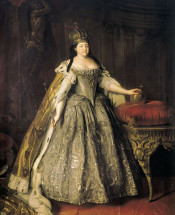
Anna Ioannovna's “Luxurious Age”. The Presidential Library’s materials illustrate the reign of the Russian empress
February 7, 2021 marks the 328th anniversary of the birth of Empress Anna Ioannovna. To learn more about the Russian autocrat and the ten-year period of her reign is now possible thanks to the historical research and documentary evidence of the extensive collection of the Presidential Library The House of Romanov. The Zemsky Sobor of 1613, one of the parts of which is dedicated to Anna Ioannovna. The unique materials presented on the portal and in the collections of the institution give an idea of her not only as an empress, but also as a very extraordinary personality.
The daughter of Tsar Ivan Alekseevich, brother of Peter I, and Tsarina Praskovya Feodorovna, Anna Ioannovna “was naturally gifted with a sound mind and sensitive heart; but the circumstances of her life were so unfortunate that these natural qualities...did not receive the proper development", the historian Dmitry Korsakov wrote in his historical study The Accession of Empress Anna Ioannovna (1880). At the age of seventeen, Anna was married to the Duke of Courland, Friedrich Wilhelm. After only two months, she was widowed and for about twenty years she lived almost without a break in Courland.
The sudden death of the young Russian Emperor Peter II on January 19 (30 according to a new style) 1730 changed the fate of the Duchess.
Events developed rapidly. On the same day, at the insistence of representatives of the Moscow nobility, an embassy was sent to Anna Ioannovna with a request "to go to Moscow and take the Russian throne without delay". Already on January 28, Anna Ioannovna signed the "Conditions" offered to her, which significantly limited the imperial power, and on February 15 she solemnly entered Moscow. Ten days later, convinced of the support of significant political forces and the guards, she signed a new petition on the liquidation of the Supreme Privy Council and the restoration of autocracy, and “Conditions” “deigned to… tear up with all the people”. On April 28, 1730, in Moscow, in the Assumption Cathedral, the solemn coronation of Empress Anna Ioannovna took place.
The Presidential Library’s collection contains a digital copy of the illustrated edition of 1730 Description of the coronation of Her Majesty the Empress, and the autocrat of all Russia, Anna Ioannovna, solemnly sent to the reigning city of Moscow, April 28, 1730, which allows imagining the scope and royal luxury of this event.
For the entourage and guests of the Empress, a meal was held in the Faceted Chamber - "there is one of the best in the Moscow residence in size and beauty". In the same place, “the great Theater was built, all in crimson velvet with gold upholstery, on which was the Imperial music...”
Anna Ioannovna was not indifferent to the theater. It was during her reign that “kunstmasters” with a puppet theater appeared in Moscow and St. Petersburg. Thus, German and Italian actors began to give performances at court. "Their repertoire consisted of funny comedies and interludes", - says theater expert Pyotr Morozov in his book History of Russian Theater until the Half of the 18th Century (1889).
However, we must pay tribute to the Empress - it was under her reign that “in 1736 an Italian opera was opened in St. Petersburg, the chief conductor of which was the Neapolitan Francesco Araya; performances have been opened in the new theater, in the Summer Garden, with an opera ("drama on music"): "The power of love not hate".
At the same time, Anna Ioannovna, according to Korsakov's testimony, "is passionately fond of shooting at a target, baiting, kennels and menageries." Almost every day she visited “...Byron’s arena...In the arena she rode on horseback, examined the horses, shot; often there were also appointed audiences”, - says Prince Dolgorukov in his turn.
But, perhaps, the most famous entertainment of Anna Ioannovna, which went down in history, was the Ice House, erected to please the empress between the Peter and Paul Fortress and the Winter Palace in February 1740. The Ice House was under construction for the wedding of the cracker Avdotya Buzheninova and Prince Golitsyn, known in the clown "rank" as Kvasnik. For the celebration, it was ordered to bring to St. Petersburg two representatives of all peoples living in Russia, in national clothes and with national instruments. There were 300 of them. All of them - some on camels, some on deer, some on oxen, and some on dogs - followed the newlyweds on an elephant "by train". After the wedding, a feast and a dance took place, and then Kvasnik and Buzheninova were taken to the Ice House. A full description of the "ice house" and the things that were in it (and literally everything was made of ice - furniture, dishes and even firewood) was made in 1741 by academician Georg Wolfgang Kraft, an electronic copy of this document is available on the Presidential Library portal.
...“The luxury of Anna Ioannovna's courtyard amazed with its splendor even the familiar eye of the courtiers of Windsor and Versailles ... Balls, masquerades, kurtags, receptions, an Italian opera, ceremonial dinners, solemn receptions of ambassadors, military parades, weddings of “high persons”, fireworks - a motley kaleidoscope replaced one another...", - reports the publication The Time of Emperor Peter II and Empress Anna Ioannovna: based on the notes of Prince P. V. Dolgorukov.

